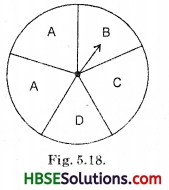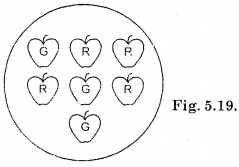Haryana State Board HBSE 8th Class Maths Solutions Chapter 5 Data Handling Ex 5.3 Textbook Exercise Questions and Answers.
Haryana Board 8th Class Maths Solutions Chapter 5 Data Handling Exercise 5.3
Question 1.
List the outcomes you can see in these experiments.
(a) Spinning a wheel
(b) Tossing two coins together.

Solution:
(a) Outcomes you can see in Spinning a wheel are : A, B, C, D and A.
(b) Possible outcomes are : (HH), (HT). (TT) and(TH).
Question 2.
When a die is thrown, list outcomes of an event of getting
(i) (a) a prime number
(b) not a prime number
(ii) (a) a number greater than 5
(b) a number not greater than 5.
Solution:
(i) (a) A prime number : 2 3, 5.
(b) Not a prime number : 4, 6.
(ii) (a) a number greater that 5 is 6.
(b) a number not greater than 5 are : 1, 2, 3 and 4.
![]()
Question 3.
Find the :
(a) Probability of the pointer stopping on Din (Question 1-(a)).
(b) Probability of getting an ace from a well shuffled deck of 52 playing cards ?
(c) Probability of getting a red apple. (See Fig. 5.19).

Solution:
(a) Number of possible outcomes for pointer stopping on D = 1.
Total number of outcomes of the experiment = 5.
∴ P(the pointer stopping on D) = \(\frac{1}{5}\)
(b) Total no. of aces = 4
Total number of outcomes = 52
∴ P (an ace) = \(\frac{4}{52}\) = \(\frac{1}{13}\)
(c) Number of Red apples = 4
Total number of outcomes (apples) = 7
∴ P (getting a red apple) = \(\frac{4}{7}\)
Question 4.
Numbers of 1 to 10 are written on ten separate slips (one number of one slip), kept in a box and mixed well. One slip is chosen from the box without looking into it. What is the probability of:
(i) getting a number 6 ?
(ii) getting a number less than 6 ?
(iii) getting a number greater than 6 ?
(iv) getting a 1-digit number ?
Solution:
(i) Number of slip written 6 on it = 1
Total number of outcomes (slips) = 10
∴ P (getting a number 6) = \(\frac{1}{10}\)
(ii) Numbers less than 6 are : 1, 2, 3, 4, 5 = 5
Total number of slips (outcomes) = 10
∴ P(getting a number less than 6) = \(\frac{5}{10}\) = \(\frac{1}{2}\)
(iii) Numbers greater than 6 are : 7, 8, 9, 10 = 4
∴ P(getting a number greater than 6) = \(\frac{4}{10}\) = \(\frac{2}{5}\)
(iv) One digit numbers are : 1,2, 3, 4, 5, 6, 7, 8 and 9 = 9.
Total number of outcomes =10
∴ P(1-digit number) = \(\frac{9}{10}\)
![]()
Question 5.
If you have a spinning wheel, with 3 green sectors, 1 blue sector and 1 red sector, what is the probability of getting a green sector ? What is the probability of getting a non blue sector ?
Solution:
Total number of outcomes (sectors) of the experiment = 3 + 1 + 1 = 5.
Number of green sector = 3
Number of non blue sector
= 3 green + 1 red 4
∴ P(getting a green sector) = \(\frac{3}{5}\)
P(getting a non blue sector) = \(\frac{4}{5}\)
![]()
Question 6.
Find the probabilities of the events given in Question 2.
Solution:
(i) (a) P(a prime number) = \(\frac{3}{6}\) = \(\frac{1}{2}\)
(b) P(not a prime number) = \(\frac{2}{6}\) = \(\frac{1}{3}\)
(ii) (a) P(a number greater than 5) = \(\frac{1}{6}\)
(b) P(a number not greater than 5) = \(\frac{4}{6}\) = \(\frac{2}{3}\)